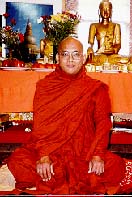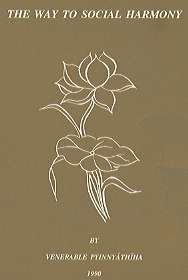
THE WAY TO SOCIAL HARMONY
VENERABLE PYINNYATHIHA
1990

 |
THE WAY TO SOCIAL HARMONYVENERABLE PYINNYATHIHA1990 |

|
CONTENTS |
|
|
THE TEACHING OF THE BUDDHA |
|
|
DOMESTIC RESPONSIBILITIES |
|
|
SOCIAL RESPONSIBILITIES |
|
|
SPIRITUAL RESPONSIBILITIES |
|
BIOGRAPHY OF VENERABLE PYINNYATHIHA Ashin Pyinnyathiha was born on Thursday, the 13th waning day of Tansaungmone in 1312 of Burmese (Kawja) Calendar, 7 December 1950, in Thaungon Village,Hsinbyukyun Township, Magwe Division, Myanmar (Burma). He ordained as a Samanera (Novice) at the age of eleven. He was ordained a Bhikkhu (Monk) at Jawtikaron Monastery in Pyay Township in 1969. In 1970 and 1971, he attained the certificates on Pitaka Lectureship level namely Dhammacariya and Digha Nikaya. In 1982, he was awarded the degree of Bachelor of Arts (B.A.). During his years in Mahasi Sasana Yeiktha, Ashin Pyinnyathiha practised meditation under the guidance of the Late Venerable Mahasi Sayadaw, and he later gave training to Yogis . He has been the Resident Sayadaw the at the 'London Vihara' in Wembley, London from 1986 to 1995 when he moved to the Loka Chantha or the Universal Peace Buddha Temple in New York, on the invitation of the America Burma Buddhist Association (ABBA). He has been serving religious duties as a devout Bhikkhu at Mahasi Satipatthan Yeiktha in New Jersey, which is a branch of the Loka Chantha Monastery. |
|
by Venerable Hammalawa Saddhatissa M.A., Ph.D., D.Litt The Buddhasasana - the dispensation of the Buddha is three fold: the teaching, the practice and the realisation. The main target of Buddhists is the realisation of the truth in its true perspective (yathabhutananadassana). In order to attain to that realisation one must practise the Dhamma according to the teaching of the Buddha. The practice could be embarked upon by learning the teaching of the Buddha. However, no realisation is possible without practice. Also, practice is not possible without the proper learning of the Dhamma. 'The Way to Social Harmony' very clearly and succinctly deals with the above threefold Buddhasasana. The author, Venerable U Pyinnyathiha, is well versed in the Buddhist canon, having studied it at the feet of great learned Burmese masters and practised meditation according to their instructions for many years. He is therefore well qualified to write a book like this. On every page it is evident that he is explaining the Dhamma from his own experience. He has written this with meticulous care, patience and devotion. It is not out of place to mention that some authors have excellent knowledge but haven't any experience of the Dhamma. Books by such authors are unfortunately not very helpful for the readers who are genuinely desirous to practise the Dhamma, but our author, Venerable U Pyinnyathiha, has both qualifications - knowledge of the Dhamma and its experience. When one reads his book, naturally one feels that the author has truly realised the Dhamma. 'The Way to Social Harmony' deals with a number of facets of the Dhamma. Social ethics, rights and duties of a layperson, and meditation and the realisation of nibbana. If anyone reads this hook carefully and follows its advice he will come to realise that happiness can be achieved by leading an exemplary family life. I therefore recommend this book to all lay people without exception, showing what a happy family life is and how to attain to it. The vast majority of the world's population are leading family lives; this is a valuable manual for all of them. London 1989 |
|
Being grateful to those who give help such as giving and teaching something, protecting one from danger, and preventing one from bad habits is the habitual practice of good people. Once the Buddha said, "These two persons are hard to find in the world. What two? The one who has previously done some act of kindness towards others and the person who is grateful to those who helped him." The first one is like a creditor and the other is like a debtor. There are too many creditors for me to list. Perhaps the loss of one leg cannot have much effect on a centipede, whereas in the case of a tripod it is disastrous. To publish this book I needed help from people of all walks of life and I got it. Their benevolence makes it rewarding for me to live in England, to learn English, to write and publish two books. I am sure that they did not help me in the hope of getting something back, nevertheless I feel I must reciprocate their benevolence. I do not have the capacity to repay them materially; only spiritually. That is why, I intend to repay my debt to them by writing more books and propagating the teaching of the Buddha as well as I can. |
|
Before I finished writing a draft of this book, whenever I was asked what I was doing, my reply was that I was writing about social responsibilities as preached by the Buddha in the Singala Sutta. Dr. Mirko Fryba from Switzerland asked if I had read Buddhist Ethics by Venerable Hammalawa Saddhatissa and suggested I should read it because the author had already explained about the subject. And when I told Venerable Saddhatissa about my work, he recommended the book 'The thirty-eight blessings for world peace' by Venerable U Nanadicca which was very good on that subject. After that I thought that first I should read the two books and if I found the subject already presented thoroughly and perfectly, I would stop my work. There is a famous story in Burmese history about two learned bhikkhus. They were Venerable Munindaghosa (Taungphila Sayadaw) and Venerable Jambudhaja (Shwe Oo Min Sayadaw). They were translating the Vinaya Pali text into Burmese at the same time. Venerable Munindaghosa was supported by the ruler and lived in the city and had many devotees but the other Sayadaw was not like him; he lived as a forest hermit. One day when Venerable Munindaghosa went on a pilgrimage to central Burma, he reached the village near where Venerable Jambudhaja lived and he hoped to meet him. While Venerable Jambudhaja was cleaning the pagoda, he met him and asked, "Oh, old novice, can you tell me how to get to the monastery where Venerable Jambudhaja lives". Venerable Jambudhaja pointed out the way to the monastery and then paid respect to the pagoda and went back to his monastery to prepare a seat for the visiting Sayadaw. When Venerable Munindaghosa arrived at his monastery he welcomed him and offered him a seat. Venerable Munindaghosa asked where Venerable Jambudhaja Sayadaw was and only then Venerable Jambudhaja admitted who he was. Venerable Munindaghosa was amazed at the latter's humility and was ashamed for mistaking the elder for an old novice. Then they conversed together and Venerable Munindaghosa asked "Aren't you afraid to live alone?" Venerable Jambudhaja replied, "It is because I am afraid that I live alone." Venerable Munindghosa understood what the other meant and felt ashamed of associating with people. When their conversation came round to the subject of their translation of the Vinaya, Venerable Munindaghosa asked for Venerable Jambudhaja's translation to compare with his and found it so good and thorough that he decided to enshrine his own unfinished translation in a pagoda. Likewise, I read the works of Venerable Saddhatissa and Venerable Nanadicca thoroughly and found they were very good. But my approach to the subject is different from theirs so I have decided not to enshrine my book in a pagoda but to present it to the public. The man who seeks to crown his life with prosperity should study this book thoroughly. The social responsibilities laid down by the Buddha in the Singala Sutta are so beautiful in their simplicity that all people of intelligence and good will, no matter what their own creed may be, should acknowledge and pay attention to them. Even though social responsibilities are described completely in the Singala Sutta, I presented other teachings of the Buddha relevant to the subject so that the readers can get an opportunity to study them. I wrote this book bearing in mind the following advice. My teacher said: "You should never intend to exploit the teaching of the Buddha but you should only think of what you can do to propagate the teachings." My lay supporter, the President of the Mahasi Meditation Centre's Supporters association said: "I would not like to read about the material progress of the Western world because it is not unknown to me. Let me know about the development of the teaching of the Buddha in the West and how you manage to propagate it there." My fellow-bhikkhu, Venerable Pesala said: "You are not trying to show your skill in the English language. If a reader wants to read good English he can read an English author's work. But if he wants to know about Buddhism, he will read your book whether or not the English is good." I have done the best that I can but if any readers find any mistakes, either in the grammar or in the ideas, I hope that they will be kind enough to tell me about it. |
|
To encourage the reader who would like to read in full the stories which I have summarised in brief the references are given in the footnotes. The references to the Pali Text Society's books are to the page numbers in the Pali Text which, in the translations, are given in square brackets at the top of the page or in the body of the text. This is because there is often more than one edition of the translations, the page numbering of which will not be the same. A Anguttaranikaya Gradual Sayings *A Atthakatha Commentary on * D Dighanikaya Dialogues of the Buddha Dhp Dhammapada (References are to verse numbers) Ibid Ibidem (Latin) In the Same Place Ja Jataka Stories of Buddha's Former Births M Majjhimanikiya Middle Length Sayings S Samyuttanikaya Kindred Sayings VbhA Vibhanga-atthakatha The Book of Analysis Vism Visuddhimagga The Path of Purification |
|
This page at Nibbana.com was last modified: